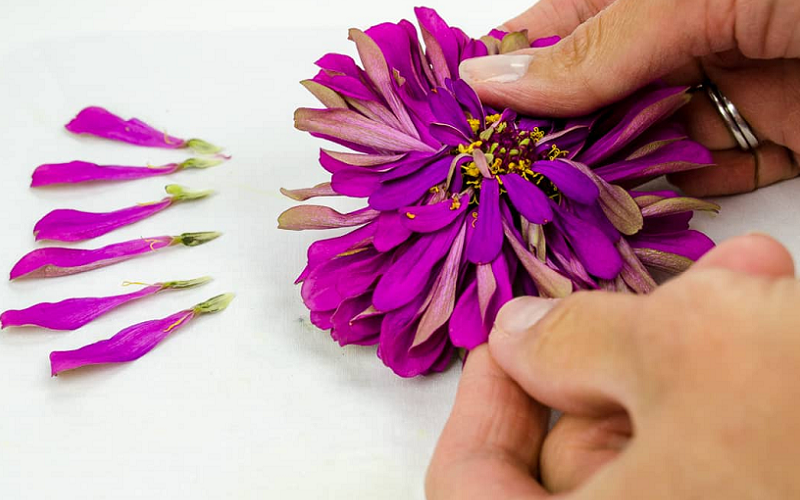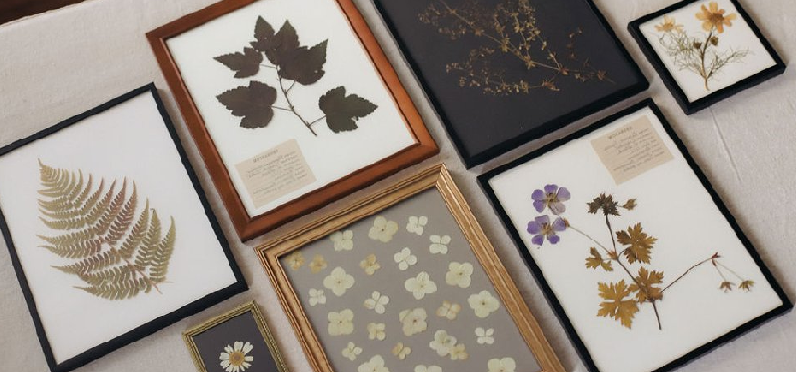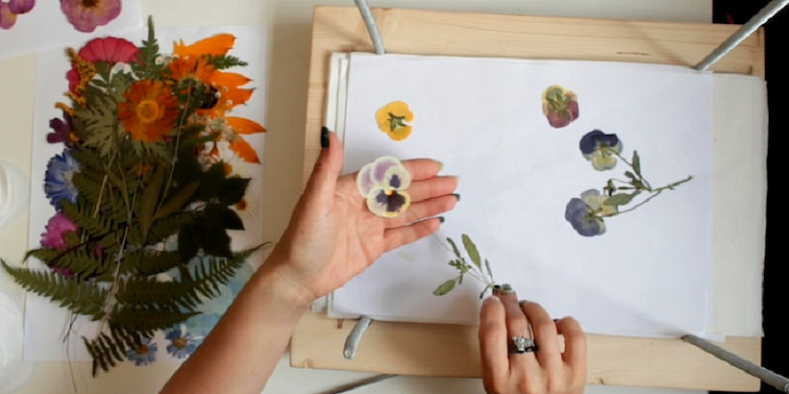
Pressed flower art is a timeless craft that encapsulates the ephemeral beauty of nature, transforming delicate blossoms into lasting mementos. It’s an art form that bridges the gap between nature and creativity, allowing us to preserve and cherish the fleeting moments of spring and summer. Here we explore the enchanting world of pressed flower art, delving into its rich history, therapeutic benefits, and the process of creating your own exquisite masterpieces.
History of Pressed Flower Art
Pressed flower art has a rich and diverse history, spanning different cultures and time periods. The practice of preserving plants, including flowers, can be traced back thousands of years and has evolved throughout the ages.
Origins and Early Uses
The earliest known use of pressed flowers dates back to ancient Egypt, where they were used to decorate burial sites and tombs, symbolizing the eternal beauty of life. Similarly, in ancient China, pressed plants were used in traditional medicines and for spiritual purposes.
Herbariums and Botanical Studies
During the Middle Ages, the practice of pressing plants gained scientific importance as botanists began to create herbariums, collections of preserved plant specimens used for study and classification. This marked a shift from merely decorative purposes to a more educational and research-based approach.
Victorian Era and Its Influence
The Victorian era (1837-1901) brought a renewed enthusiasm for pressed flower art, as it became a popular pastime, especially among women. It was during this time that the art form began to flourish as a creative expression and a means of social engagement. Victorians would exchange intricately designed floral arrangements as tokens of friendship, love, and sentiment. The practice of creating albums filled with pressed flowers, ferns, and leaves, known as “floriography,” became a fashionable hobby.
Oshibana: The Japanese Art of Pressed Flowers
Oshibana, the Japanese art of pressing flowers, originated in the late Edo period (1603-1868). It’s a highly refined and intricate art form where each flower, leaf, and stem is carefully arranged to create beautiful compositions. Oshibana emphasizes the natural beauty of each plant, focusing on harmonious colors, textures, and shapes, and often incorporates calligraphy and poetic verses.
Modern-Day Adaptations and Resurgence
In recent years, pressed flower art has experienced a resurgence, with artists and hobbyists alike embracing the craft for its sustainability, mindfulness, and connection to nature. The rise of social media platforms has played a significant role in its renewed popularity, as artists from around the world showcase their unique and innovative creations. Pressed flower art now graces everything from greeting cards and bookmarks to jewelry and home décor, making it a versatile and accessible art form for everyone to enjoy.

Benefits of Pressed Flower Art
Pressed flower art not only provides a visually stunning and unique way to capture nature’s beauty but also offers various benefits that can positively impact our well-being and the environment.
Therapeutic and Meditative Qualities
Engaging in pressed flower art can be a meditative and calming experience, as it requires patience, focus, and mindfulness. Taking the time to carefully arrange and press flowers allows you to slow down and appreciate the intricate details of each petal and leaf. This mindful practice can help reduce stress, alleviate anxiety, and promote a sense of well-being.
Environmental Impact and Sustainability
Creating art with pressed flowers is an environmentally friendly and sustainable practice, as it encourages the use of natural materials instead of synthetic or non-biodegradable alternatives. By using flowers from your own garden or locally sourced blooms, you can minimize your carbon footprint and contribute to a greener lifestyle. Pressed flower art helps to raise awareness and appreciation of nature’s beauty, inspiring others to value and protect the environment.
Unique and Personalized Gifts
Pressed flower art offers endless opportunities to create one-of-a-kind gifts that are both meaningful and beautiful. By preserving a special flower from a wedding, anniversary, or other significant events, you can create lasting memories for yourself or loved ones. Handmade pressed flower creations, such as cards, bookmarks, or framed pieces, make thoughtful presents that showcase your personal touch and artistic flair.
Boosting Creativity and Artistic Skills
Experimenting with pressed flower art can help you develop new artistic skills and explore your creativity. Arranging flowers and leaves into unique compositions requires a keen eye for design, color harmony, and balance. As you become more proficient in the craft, you’ll find that your artistic instincts grow stronger, allowing you to create increasingly complex and visually appealing pieces.
Connection to Nature and Seasonal Awareness
Working with pressed flowers deepens your connection to the natural world and heightens your awareness of the changing seasons. As you collect and press flowers throughout the year, you’ll become more attuned to the subtle shifts in your local flora and develop a greater appreciation for the transient beauty of each season.

Selecting and Harvesting Flowers for Pressing
Choosing the right flowers and harvesting them correctly is crucial to the success of your pressed flower art.
Best Flowers to Use for Pressing
While you can press most flowers, some varieties work better than others due to their structure, size, and moisture content. Ideal flowers for pressing are generally flat, thin, and have low moisture content. By carefully selecting and harvesting your flowers, you’ll set the foundation for beautiful and long-lasting pressed flower art. Here are some popular options:
- Pansies
- Violets
- Daisies
- Ferns
- Roses (petals)
- Larkspur
- Queen Anne’s Lace
- Baby’s Breath
- Lavender
Experiment with different flowers to discover which ones yield the best results and match your artistic vision.
Timing and Method of Harvesting
To achieve the best color retention and overall quality, consider the following tips when harvesting flowers for pressing:
- Pick flowers in the morning after the dew has dried but before the heat of the day sets in. This ensures the flowers are fully hydrated but not damp.
- Choose flowers that are not fully open, as they are less likely to lose their petals during the pressing process.
- Harvest flowers that are free of blemishes, insects, and damage. Healthy blooms will produce better results and maintain their beauty over time.
Tips for Maintaining Flower Quality
Once you’ve harvested your flowers, follow these guidelines to preserve their quality before pressing:
- Remove any dirt or debris by gently shaking the flowers or using a soft brush.
- If necessary, you can gently rinse the flowers in water, but be sure to let them air dry completely before pressing.
- Remove excess foliage from the stems, as this can retain moisture and lead to mold or decay during the pressing process.
- Store flowers in a cool, dry place if you’re unable to press them immediately. You can place them between layers of paper towels or tissue paper and keep them in the refrigerator for a short period.

Techniques for Pressing Flowers
To transform fresh flowers into stunning pressed flower art, you’ll need to master the art of pressing. Several techniques can be used to press flowers, each with its pros and cons.
Traditional Flower Press
A flower press is a dedicated tool designed specifically for pressing flowers. It consists of layers of cardboard or blotting paper, separated by wooden or metal plates, and tightened using screws or straps. To use a flower press:
- Arrange flowers between sheets of blotting paper or cardboard, ensuring they don’t overlap.
- Place the layered flowers inside the flower press.
- Tighten the screws or straps to apply even pressure.
- Wait for 2-4 weeks, checking periodically for progress.
Pros: Provides even pressure, easy to use, and reusable.
Cons: Can be expensive, takes longer to press flowers, and occupies space.
Microwave Flower Pressing
Microwave flower pressing is a modern and time-efficient method that uses a microwave-safe flower press or ceramic tiles. To press flowers using this method:
- Place the flower between two sheets of microwave-safe paper, such as parchment paper.
- Position the paper inside a microwave-safe flower press or between two ceramic tiles.
- Microwave on a low setting for 30 seconds to 1 minute, checking frequently to avoid overheating.
- Let the flower cool before removing it from the press.
Pros: Quick results, usually taking only a few minutes, and preserves vibrant colors.
Cons: Requires a microwave-safe flower press or ceramic tiles, and can overheat or damage flowers if not done carefully.
Ironing Method
Pressing flowers with an iron is another technique that delivers relatively quick results. To press flowers using an iron:
- Place the flower between two sheets of absorbent paper, such as parchment or blotting paper.
- Set the iron on a low heat setting, without steam.
- Gently iron the top sheet of paper, applying even pressure.
- Continue ironing for 2-5 minutes, checking the flower regularly for progress.
Pros: Faster than traditional pressing, doesn’t require a special press, and most households have an iron.
Cons: Requires constant attention to avoid burning the flowers, and can result in uneven pressure.
Heavy Book Method
The heavy book method is a simple and cost-effective way to press flowers, requiring only paper and a heavy book. To press flowers using this technique:
- Place the flower between two sheets of absorbent paper, such as tissue or parchment paper.
- Insert the paper with the flower inside a heavy book, ensuring the flower remains flat and doesn’t shift.
- Add more weight on top of the book, such as other heavy books or a weight.
- Wait for 2-4 weeks, checking periodically for progress.
Pros: Inexpensive, easy to set up, and doesn’t require any special equipment.
Cons: Takes longer to press flowers and can result in uneven pressure.
Arranging and Designing with Pressed Flowers
Once your flowers are pressed, the creative process of designing and arranging your pressed flower art begins. This is where your artistic skills and personal style shine, as you create unique compositions using your preserved blooms.
Inspiration and Ideas for Designs
Finding inspiration for your pressed flower art is key to creating meaningful and visually appealing designs. Here are some ideas to get you started:
- Nature: Look to the natural world for inspiration in terms of color combinations, shapes, and patterns.
- Art and photography: Study the compositions and techniques of your favorite artists or photographers to inform your own arrangements.
- Personal memories: Design layouts that evoke special moments, places, or people in your life.
- Themes: Create seasonal, floral, or abstract themes to guide your designs.
Composition and Layout
Creating a balanced and harmonious composition is essential for a visually pleasing pressed flower arrangement. Keep the following principles in mind when designing your layout:
- Balance: Distribute visual weight evenly across your design by considering the size, shape, and color of the flowers and leaves.
- Focal point: Choose a central element or area that draws the viewer’s attention, and arrange the remaining elements to complement or support it.
- Repetition and rhythm: Repeating elements, such as colors, shapes, or patterns, can create a sense of unity and rhythm in your design.
- Contrast and variety: Incorporate contrasting elements, such as different textures, colors, or shapes, to add visual interest and depth to your composition.
Adding Additional Elements and Textures
Pressed flowers are the star of your artwork, but incorporating additional elements can enhance your design and add personal touches. Consider the following ideas:
- Mixed media: Combine your pressed flowers with other art forms, such as painting, drawing, or collage, to create unique mixed-media pieces.
- Text and calligraphy: Add handwritten or printed text, such as poetry, quotes, or personal messages, to your design.
- Embellishments: Incorporate decorative elements, like beads, ribbons, or lace, to enhance your arrangement and add texture.
Experimentation and Practice
As with any art form, practice and experimentation are essential for refining your skills and developing your personal style. Don’t be afraid to try new techniques, rearrange your flowers, or even start over if a composition isn’t working. The more you work with pressed flowers, the more confident you’ll become in your artistic abilities and creative instincts.
By focusing on inspiration, composition, and incorporating additional elements, you’ll create visually stunning and unique pressed flower art that captures the essence of nature’s beauty. Remember, there’s no right or wrong way to design your pressed flower arrangements—let your creativity and personal style guide you as you transform preserved blooms into unforgettable masterpieces.







